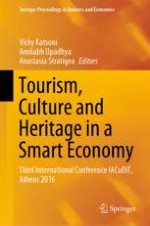2017 | OriginalPaper | Chapter
Social Media Tools and (E)Destination: An Italian Case Study
Authors : Anna Paola Paiano, Lara Valente, Valentina Ndou, Pasquale Del Vecchio
Published in: Tourism, Culture and Heritage in a Smart Economy
Publisher: Springer International Publishing
Activate our intelligent search to find suitable subject content or patents.
Select sections of text to find matching patents with Artificial Intelligence. powered by
Select sections of text to find additional relevant content using AI-assisted search. powered by
